Inspection of Immigrants (1908-1911)
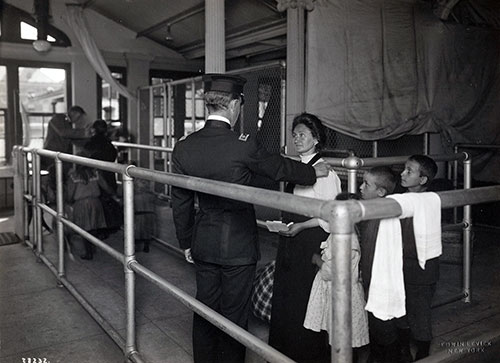
Immigrants Undergoing Medical Examination at Ellis Island ca. 1908. New York Public Library. | GGA Image ID # 21ea6126d5
The loosely conceived notion that the federal government regards the matter lightly is erroneous. The well-meant efforts of newspaper and magazine writers to arouse the public to realize the dangers of immigrants confront us but suggest questions that have long received the earnest thought of the authorities. For one, the great questions of immigration and naturalization should follow the other and make the question. Still, one has involved the study and labor of some of the brightest men of our times.
Persons who would like more comprehensive information on the matter than can be given here will do well to read the Annual Report of the Secretary of Commerce and Labor from year to year. The one for 1908 contains some thoughts of great interest. Permit me to quote from there:
The facility and cheapness of communication, especially in ocean travel, during the last two decades, which has contributed so materially to immigration to this country, has likewise contributed to emigration from this country to other lands, as the figures I have referred to indicate. It has also influenced the migration from this country of native-born citizens to a much lesser degree.
Some regard this significant emigration of aliens and naturalized citizens as an additional objection to immigration in general since many of this class who come to this country, and by industry and economy, accumulate what will give them, in the land of their origin, a reasonable competency, return to it, either for a temporary sojourn or to spend their remaining years.
This subject has other essential aspects which should not be lost sight of. Notwithstanding the significant increase in immigration during the past decade, the wage standard of this country has not been lessened; on the contrary, it has continued to increase. In recent years, the immigrants have also contributed materially toward transplanting new industries from the countries they emigrated to and expanding, among other sectors, those that had already been transplanted and established.
One can also state that the immigrant laborer as a class usually finds employment at the bottom of the industrial scale, thereby leaving the higher grades, where work is more remunerative, to the native workman.
In a commercial sense, this emigration is not without significance. The immigrant who comes to this country lives here for many years and returns either to his own country or to some other country, which naturally takes with him the money he has through thrift and industry, to a greater or lesser extent.
American ideals, American tastes, and American requirements. These are consciously or unconsciously transplants. The consequence of this emigration upon our foreign trade, primarily upon our exports, is not inappreciable. The emigrant is a commercial missionary.
His desire for many of our manufacturers, with the need of which he has become accustomed, has likely contributed to the export of such products, both directly and indirectly, to the country to which he has emigrated.
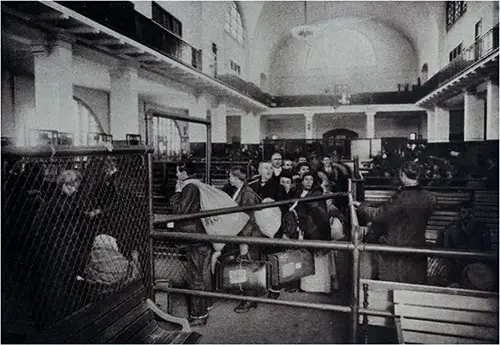
Immigrants Filing Past the Doctors at Ellis Island. Quarantine Sketches, 1902. | GGA Image ID # 21ea6dfc6d
There is still a larger view, which one may adequately take and should not be disregarded. When normal and not induced by oppression or persecution, this migration has a far-reaching influence in interpreting one nation to another, establishing closer relations, and promoting the world's peace.
Charles Sumner, no doubt, had this phase of the subject in view, together with other causes, when he stated that "the national example will be more puissant than army and navy for the conquest of the world." In his "Prophetic Voices Concerning America."
A thoughtful reading of this quotation will answer most of the arguments against our commingling with aliens. And when we find that this Department of Government activity is one of the most potent agents in suppressing the white slave trade.
The perversion of labor attempted by heartless contractors for foreign labor, the attempt to force oriental labor standards upon our Pacific coast, the shipping of the morally and physically unfit to our shores, and other things threatening our country, we will come to know that the government is very much awake to the interests that good citizens hold most dear.
The inquirer should then read the Annual Report of the Commissioner-General of Immigration yearly. A few data will be selected from the last reports received. The matter at large hardly concerns the scope of the present volume.
There are four lines of work: the Bureau proper, the Chinese division, the division of information, and the division of naturalization. There is a working agreement with the steamship companies for which the deported aliens are well provided. The laws require that every person entering has sufficient money for present purposes. Each immigrant brings in an average of about twenty-three dollars.
About 1.3 percent of the total number applying for admission were turned back; in 1908, there were 370 rejected for mental and nervous diseases, 3,740 for pauperism, 2,900 for contagious diseases, 53 for tuberculosis, 136 for criminality, 124 for prostitution, and other moral causes, 43 for importing prostitutes, and 1.932 for coming as contract laborers.
The department is making every effort to place these aliens in such locations and occupations as will be of the most significant economic value to the country and the most excellent aid to the aliens themselves. Steamship companies and European moneylenders' exploitation of possible or probable immigrants is now largely in check.
The following quotation from the 1908 report illustrates the department's investigations of abuses. It indicates the conditions met by the officials and corrected mainly by them.
One of the Bureau's inspectors, Mr. A. A. Seraphic, thoroughly versed in the Greek language and its customs and business methods, has devoted considerable time during the past year to investigating the Greek shoe-shining establishments of several large cities and has submitted an able and fascinating report, which would be quoted but for lack of sufficient space.
He prefaces his report by describing the conditions under which young Greek boys are apprenticed or bound out in Greece and Turkey at wages ranging from $10 to $20 per year, finding employment with roving bootblack bosses, peddlers, café, and restaurant proprietors.
Keepers of combination groceries and saloons also show that the hours of labor are incredibly long, often extending from six A.M. to twelve P.M. The food furnished by the apprentices is barely sufficient to keep body and soul together.
This he assigns as the principal explanation of the willingness of Greek boys to come to the United States under the padrone system and to be held in practical slavery by the padrones for terms of years under conditions concerning pay, hours of labor, and living accommodations which are abominable, according to the standards of this country, but are considerably better than those existing in their native land.
The Greek padrones have practically monopolized the bootblacking business in the United States, which is explained by the fact that they obtain their labor under conditions that preclude competition by persons of other races. The proprietor of a stand can earn $300 to $500 a year from the labor of each boy imported.
The boys' wages range from a minimum of $80 to a maximum of $250, the average being about $150 per year. According to the locality, the boys must turn over to the padrones all tips they collect, and such collections amount from forty cents to two dollars per day.
The padrones keep the boys closely confined to their places of occupation and allow them to come in contact with outsiders only so far as necessary. The object is to prevent them from learning of labor conditions in this country or becoming acquainted with the English language so that they can continue to practice imposition upon them.
As a rule, the places in which the boys live are highly unsanitary. These unsanitary conditions, especially in the sleeping quarters, close confinement to work in areas generally overheated and poorly ventilated, the stooping position which they must constantly assume, and the improper nourishment as a rule received, all combine to injure the constitution of the boys and render them anemic, debilitated, and subject to pulmonary troubles.
Inspector Seraphic further shows that, as a rule, the importation of Greek boys is so arranged as to make it extremely difficult, if not impossible, to secure evidence upon which either to deport the boys or to prosecute the importers. The plan principally followed was to claim fictitious relationships and coach the boys to prevent them from being broken down on examination.
Notwithstanding this handicap, however, up to the time of submitting his report, April 7, 1908, the inspector had been able to place in the hands of the United States attorney's evidence on which two padrones of Boston were obliged to plead guilty. In Chicago, fourteen were indicted, six of whom pleaded guilty. Two were tried and found guilty. Proceedings against the remaining six are still pending.
Hon. William Williams, the commissioner of immigration at the port of New York, kindly afforded me every opportunity to investigate the work at Ellis Island and Dr. Geo personally. W. Stoner, one of the staff of Marine Hospital surgeons, detailed the work of the medical division and gave me practical illustrations of the inspection and hospital work.
Since about seventy-five percent of the total number of immigrants arrive at this station, it is typical of the work, except as one may find it along the Canadian and Mexican borders.
One cannot but be impressed with the humane way these strangers to our shores are handled. I noted significant consideration from the commissioner down to the police.
I have had frequent opportunities to meet the United States Public Health and Marine Hospital Service surgeons and found them, at Ellis Island as elsewhere, to be physicians and gentlemen of ability and high attainment.
Observing the Immigrant Inspection Process
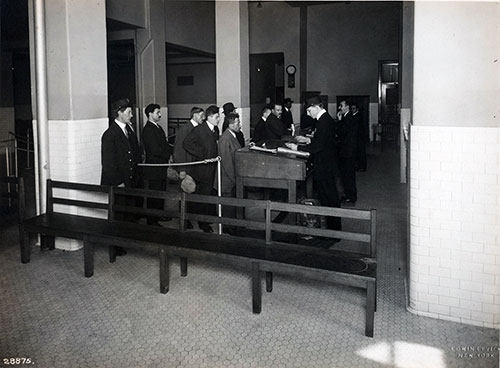
Immigrants Being Processed by Immigration Bureau Officials, 1908. New York Public Library. | GGA Image ID # 21ea700c36
At Ellis Island, they seem to cultivate their powers of observation and instantly recognize the clinical picture presented by the immigrants before them. The photographs I took there tell their tale, but the following narration gives an idea of inspection details.
I first visited the state quarantine station at Staten Island. I found that Dr. Doty and his able assistant essentially eliminate contagious cases (smallpox, yellow fever, cholera, typhoid, and typhus fevers and plague). Still, no one is detained there except for quarantinable disease or exposure.
After the state officials finish their work, the Marine Hospital medical officers board the vessel. They examine the cabin passengers and usually complete their work when the ship reaches its dock.
Those entitled to land are promptly released, but those certified to the immigrant inspector must undergo further examination or detention according to conditions determined by the laws and regulations.
Sick persons aboard are examined, and any aliens are transferred to the hospital at Ellis Island, an institution similar to any general hospital with isolation wards.
The hospital is not large, and immigration officials may assign severe cases to a contract hospital. In contrast, Ellis Island may send contagious instances to one of the special hospitals conducted by the New York City Department of Health and described in the section devoted to that work in the chapter "Local Boards of Health."
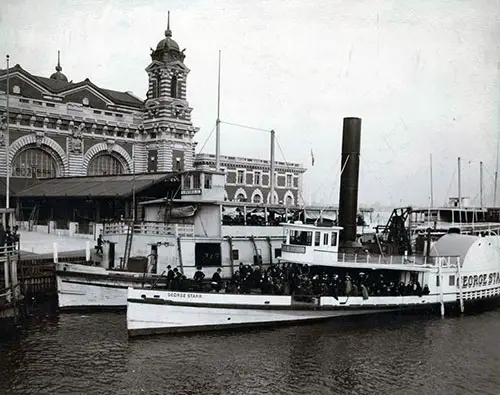
Immigrants Arriving on Barges at Ellis Island ca 1905. New York Public Library. | GGA Image ID # 21eb4ef81d
All steerage passengers are transferred utilizing barges to the immigration depot at Ellis Island. The initial medical examination there is short, but the doctor places a chalk mark upon the suspected parties' clothing at the head of the line.
At the end of the line, the doctor supplements this examination by examining the eyelids in the search for trachoma and other examinations that may seem justified in separating the fit from the unfit.
These latter are turned aside from the line and sent to special examining rooms. Those who pass are sent to the registry room or before the boards of special inquiry.
The following extract from the book of instructions, issued by the surgeon general, shows the classes examined:
To carry out the provision of the immigration law, diseased, abnormal, disabled, and deformed aliens may be regarded as divisible into two general classes.
Class A: Those who are excluded from admission into the country by reasons of a disease or abnormal condition of a character expressly declared by the law itself to constitute a ground for such exclusion.
Class B: Those who present some disease or defect, physical or mental, which may be regarded as conclusive or contributory evidence to justify the exclusion, by the proper immigration officers, of the person in question as an alien " likely to become a public charge."
Under the present law, aliens of Class A must fall within one of the four Subdivisions of that class, viz.:
- Persons suffering from dangerous contagious diseases;
- persons suffering from loathsome diseases
- Insane persons (also who have epilepsy, under the law of 1903);
- Idiots.
The following final quotation is from a paper by Dr. Stoner read by him before the New York Academy of Medicine:
In cases certified under Class A - (1) persons suffering from dangerous contagious diseases; (2) persons suffering from loathsome diseases; (3) insane persons, also people with epilepsy (under the law of 1903); (4) idiots - the law is mandatory.
In those placed in Class B and certified (or with a disease or abnormal condition "affecting the ability to earn a living" (as the certificate usually states), the immigration officer or boards of special inquiry have exercised discretion.
In some cases, the medical certificate is regarded under the law as contributory evidence only or as one of several factors constituting a condition that renders an alien "likely to become a public charge."
For example, of 1,231 aliens certified for senile debility, a majority was landed; certain favorable factors in or about many of ( these cases outweighed that of the medical certificate to such an extent that in the judgment of the board, the individuals affected were not likely to become public charges.
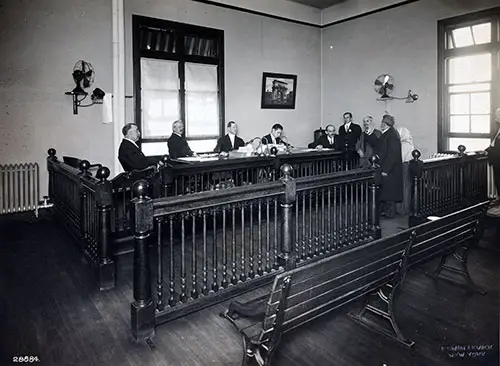
Immigrant Appears Before the Board of Inquiry ca 1907. New York Public Library. | GGA Image ID # 21eb82459c
On the other hand, upon special inquiry, an alien is denied admission on the ground that he is likely to become a public charge. He has a right of appeal to the department through the commissioner of immigration. Friends or relatives may offer a guarantee or bond against the likelihood of the alien becoming a public charge.
It is proper to say, however, that under the regulations of the immigration service, no application for admission under bond of a debarred alien will be considered, except in cases in which the deportation of the alien in whose behalf such application is made would involve the separation of immediate members of a family."
The present writer listened to the hearing of some of these unfortunate cases and found that the law is administered in a very compassionate manner.
Thos. S. Blair, M.D., “Inspection of Immigrants – Carriage of Animals from Infected Ports and Sections.” In Public Hygiene, Volume II, Public Carriers and Sanitation, Section No. VI, Boston: The Gorham Press, 1911, Pages 589-593.
Supplemental Notes
Why This Article on the Inspection of Immigrants (1908-1911) is Essential for Understanding Immigration History
The Inspection of Immigrants (1908-1911) article provides an in-depth look at how the U.S. government regulated immigration through medical and legal inspections at Ellis Island and other ports of entry. It reveals the meticulous screening process, public health concerns, and labor exploitation issues that shaped the immigrant experience.
For teachers, students, genealogists, and family historians, this article is a must-read resource to understand how immigration policies influenced the fate of millions of new arrivals. It offers a detailed firsthand account of the procedures, challenges, and the role of government in shaping immigration laws and enforcement.
Key Highlights of the Article:
1. The Role of Immigration Inspections in Public Health & National Security
- Ellis Island served as the primary inspection station for immigrants, with nearly 75% of arrivals passing through this port.
- The inspection process was rigorous, involving doctors, immigration officers, and legal boards.
- The U.S. government actively sought to prevent the arrival of criminals, anarchists, prostitutes, and those with “undesirable” medical conditions.
2. The Medical Screening Process: Who Was Allowed to Stay?
- Physicians examined every steerage passenger, searching for signs of contagious diseases, mental illness, and physical disabilities.
- Chalk-marked clothing indicated individuals who needed further examination. Common rejections included:
- 370 individuals for mental and nervous diseases
- 3,740 for being deemed paupers
- 2,900 for contagious diseases
- 53 for tuberculosis
- 136 for criminality
- 124 for prostitution and other moral offenses
- 1,932 for contract labor violations
3. The Immigration Department’s Efforts to Protect Vulnerable Immigrants
- Government officials actively fought against the exploitation of immigrant laborers, particularly Greek boys forced into indentured servitude under the padrone system.
- Many young Greek boys were brought to the U.S. under false pretenses and forced into harsh, unpaid labor conditions in bootblacking businesses.
- Investigators uncovered widespread labor abuses, leading to multiple convictions of padrones in Boston and Chicago.
4. The Growing Complexity of Immigration Laws & Policies
- By 1908, U.S. authorities had developed stricter regulations to prevent labor exploitation, human trafficking, and the importation of undesirable workers.
- Steamship companies were required to monitor passengers and repatriate rejected individuals at their own expense.
- Immigrants were increasingly required to prove financial stability and secure employment before being granted entry.
5. The Inspection Process: A Balance of Rigorous Screening and Humanitarian Consideration
- Immigrants arriving with health issues or disabilities had a chance to appeal their case, and some were allowed to stay if family members provided financial guarantees.
- The medical staff at Ellis Island demonstrated compassion while upholding strict health regulations.
- Legal hearings and special inquiry boards ensured fair treatment, even though some cases resulted in painful family separations.
Why You Should Read This Article
This article is a crucial resource for understanding the immigrant experience between 1908 and 1911—a time when the U.S. government tightened immigration laws and intensified medical screenings.
For genealogists and family historians, it offers valuable insights into why ancestors may have been detained, deported, or faced challenges upon arrival.
For students and educators, this article provides a detailed account of how immigration policies reflected broader societal fears, economic concerns, and public health priorities.
📖 Explore the full article to uncover the realities of immigration inspection, the challenges faced by new arrivals, and the evolving policies that shaped America’s immigrant history!
